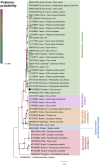First molecular identification of Spirometra mansoni in the golden jackal (Canis aureus) in Croatia
- PMID: 40860928
- PMCID: PMC12375458
- DOI: 10.3389/fvets.2025.1629099
First molecular identification of Spirometra mansoni in the golden jackal (Canis aureus) in Croatia
Abstract
This study presents the first molecularly confirmed identification of the cestode Spirometra mansoni in the golden jackals (Canis aureus) in Croatia, and possibly the first such report in Europe. Of 198 jackals examined between 2020 and 2025, adult Spirometra worms were recovered from three individuals. The morphological characteristics of these specimens were consistent with S. mansoni, and their identity was confirmed by PCR and sequencing of the mitochondrial cox1 and nad1 genes. Phylogenetic analysis grouped the obtained sequences within the S. mansoni clade, with strong posterior probability support. This finding expands the known host range and geographic distribution of S. mansoni and underscores the importance of integrating molecular diagnostics in parasitological surveys. Further research is needed to assess the role of golden jackals and other wildlife in the epidemiology of Spirometra spp. in Europe.
Keywords: Canis aureus; Croatia; Spirometra mansoni; cox1; nad1.
Copyright © 2025 Šikić, Gagović, Rojas, Sindičić, Žilić, Naletlić, Balić, Hodžić and Beck.
Conflict of interest statement
The authors declare that the research was conducted in the absence of any commercial or financial relationships that could be construed as a potential conflict of interest.
Figures



References
-
- Kuchta R, Scholz T, Brabec J, Narduzzi-Wicht B. Diphyllobothrium, diplogonoporus and Spirometra. In:Xiao L, Ryan U, Feng Y, editors. Biology of Foodborne Parasites (1st edition). Boca Raton, FL: CRC Press; (2015). p. 299-326.
-
- Kuchta R, Scholz T. Diphyllobothriidea. In:Caira, JN, Jensen K, editors. Planetary Biodiversity Inventory (2008–2017): Tapeworms from Vertebrate Bowels of the Earth. University of Kansas, Lawrence, KS, USA (2017). p. 167–89. Natural History Museum, Special Publication No. 25. Available online at: https://hdl.handle.net/1808/24421
LinkOut - more resources
Full Text Sources
Miscellaneous

